Family : Opistognathidae

Text © Giuseppe Mazza

English translation by Mario Beltramini
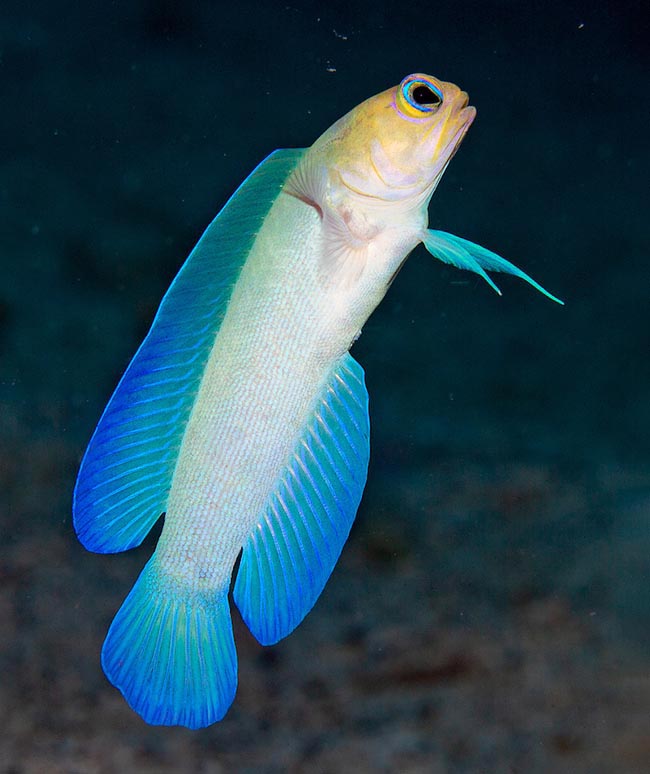
The Yellowhead jawfish, called also Miner fish as digs the den, Opistognathus aurifrons is frequent in west Atlantic from South Carolina and Bermudas to Mexico and then in Caribbean up to Brazilian coasts © Allison & Carlos Estape
For the survival of the species the majority of the marine fishes rely on quantity, entrusting thousands of eggs to the currents.
At the limit one single female of Molva molva, fish with an about 1 m long body resembling the eels, may spawn even 20-60 million of eggs.
Others, like the sardines move and reproduce in schools releasing clouds of planktonic eggs and various species gather for mass couplings with more males fecundating together the floating eggs.
The fishes who spawn on the seabeds often survey watch over the eggs until hatching, chasing away the predators.
The seahorses carry them with themselves in a ventral pouch, and then it’s the male to deliver like Hippocampus kuda, others stick them under the tail, as Phyllopteryx taeniolatus and Solegnathus spinosissimus do or under belly like in Dunckerocampus dactyliophorus.
Finally, there are those who decide to fast until the hatching and protect the fecundated eggs in the mouth.
This is the case in the fresh waters of various incubating fishes that belong to the family of the Cichlidae, where in some species the mother’s wide open mouth offers a safe refuge also to small fishes, until when there is room for them, even after birth.
Same thing is done by the males of some African Siluriformes, who then also keep the little ones for two weeks.
In the Mediterranean and the east Atlantic, from the Bay of BIscay to the Gulf of Guinea, the males of Apogon imberbis hold up to the hatching the eggs in their mouth and on the Caribbean side the Opistognathus aurifrons does the same thing, taking additional shelter, if needed, underground, in a shelter it digs and who has earned it the Italian name of Miner fish.
It belongs to the Actinopterygii, the ray-finned fishes, to the order of the Perciformes, and to the family of the Opistognathidae which counts 4 genera and 84 species, mostly small fishes with enlarged head and mouth and narrow and tapered body, who often take shelter in dens dug in the sand where they enter backwards, with the tail.
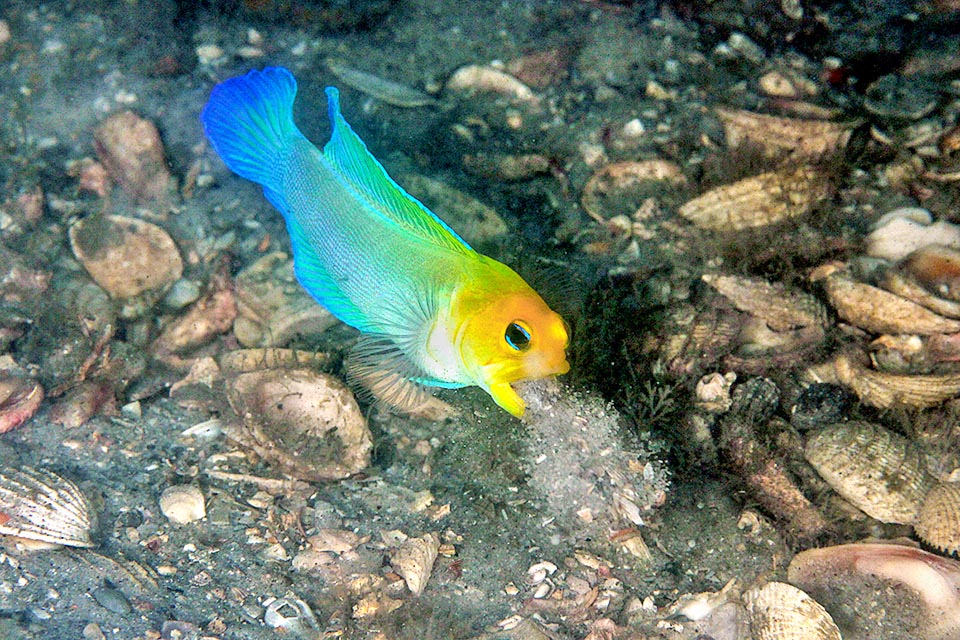
Here spitting sand from the mouth to build its shelter. It must create first an about 10 cm deep hole and slightly wider © Kevin Bryant
The genus Opistognathus like the family comes from the Greek “ὄπῐσθεν” (opisthen), behind, and “γνάθος” (gnathos), jaw, with reference to the showy upper jaw they use for digging, whilst the specific term aurifrons, adds, in Latin, that it is a fish having a golden forehead, characteristic also taken by the English name of “Yellowhead jawfish”, that is Jawfish with yellow head.
French call it “Marionnette tête d’or”, which means Golden-headed puppet, referring, without forgetting the head, to its characteristic vertical posture close to the den, where it moves up and down, as if it pulled by an invisible thread, to catch on the fly the passing-by zooplankton.
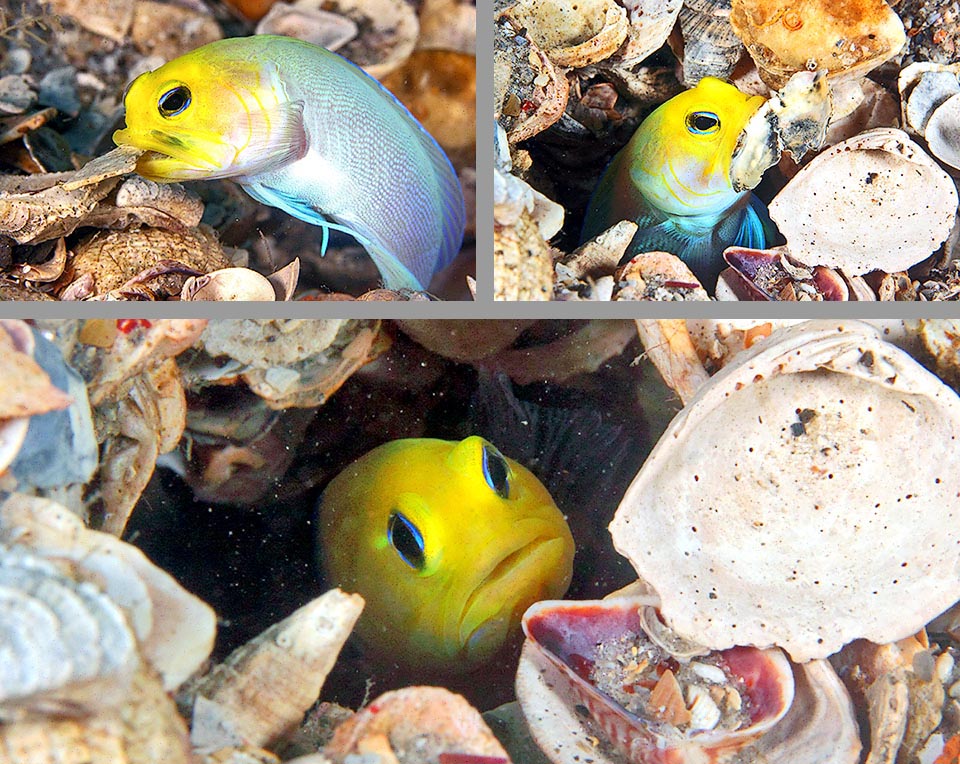
Then, starting from bottom, builds a solid underground stepped pyramid, using as bricks fragments of madrepores, rocks and shells. Dry stone walls that create a bedroom below and a corridor opening on the outer world. To note the bivalve shell, on the right in the picture, used as door to close the house when it goes to sleep © Kevin Bryant
Zoogeography
Opistognathus aurifrons has a very wide range in west Atlantic from South Carolina and Bermudas up to Mexico and Belize and then eastwards the Cayman Islands, Jamaica, Cuba, Bahamas, Turks and Caicos Islands, Haiti, Dominican Republic, Puerto Rico, Virgin Islands, Antigua, Guadeloupe, Martinica and adjacent islands up to Barbados, Grenada, Trinidad and Tobago, Aruba, Curaçao and finally the costas of Venezuela and of Brazil reaching also the archipelago of Trindade and Martim Vaz, more than 1000 km off the coasts of Espirito Santo.
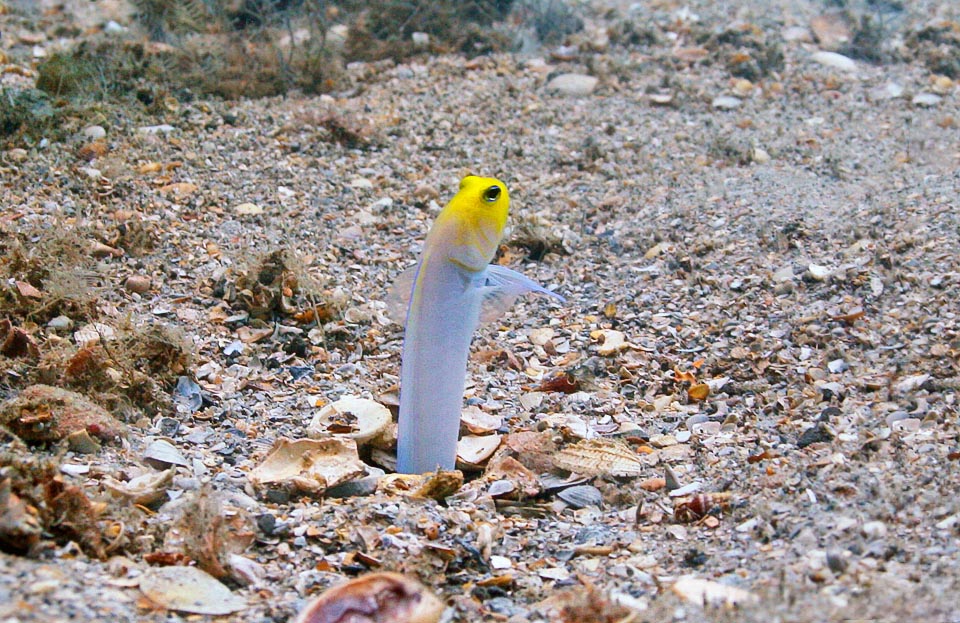
In the day it is found so almost always, vertically on the house door to catch, moving up and down like a puppet, the passing-by zooplankton © Kevin Bryant
Ecology-Habitat
The Yellowhead jawfish is a benthic species living usually at 3 to 40 m of depth, often in small colonies, on sandy seabeds rich in coral debris, small stones and shells of conches.
It does not look for a den, but creates it. For building it, digs first an about 10 cm deep hole, slightly wider, in a continuous back and forth spitting sand around. Then, starting from the bottom, it builds up a sort of underground stepped pyramid, using as bricks fragments of madrepores, rocks and shells.
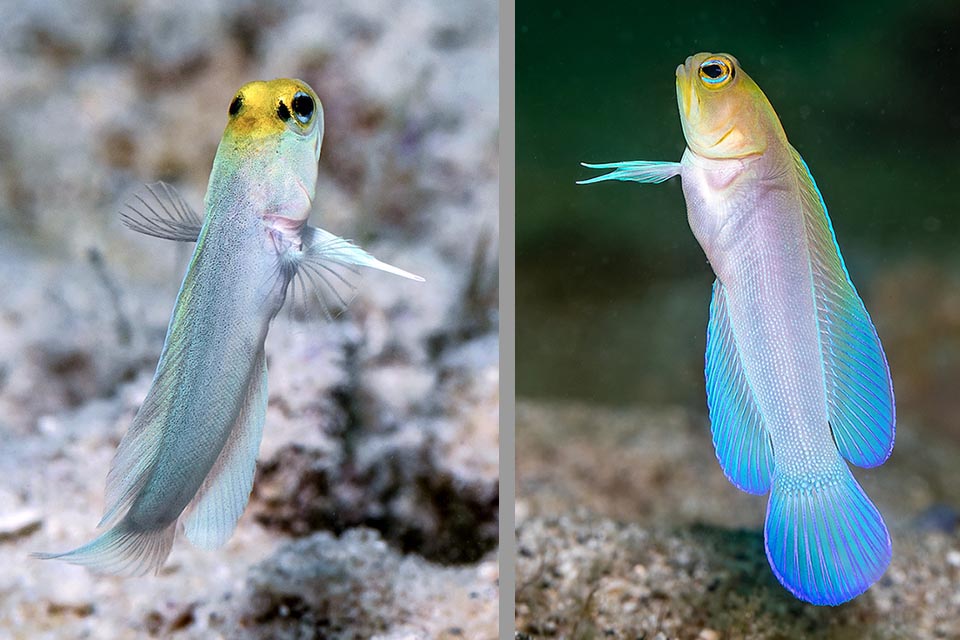
Before the reproductive time, the males can display black spots on the nape. The pelvic fins, long and sharp, much ahead than usual, look like arms © Allison & Carlos Estape
Many dry stone walls, consolidated on the outside by the sand, that above the bedroom form as getting closer, upwards, a corridor that opens on the outer world.
By day, ready to backtrack upon the first sign of danger, the Yellowhead fish emerges vertically above the opening to feed.
It moves a maximum of one and a half metres away from the den, and in the evening, when it goes to sleep, prudently closes itself at home, using often as door the shell of a bivalve.
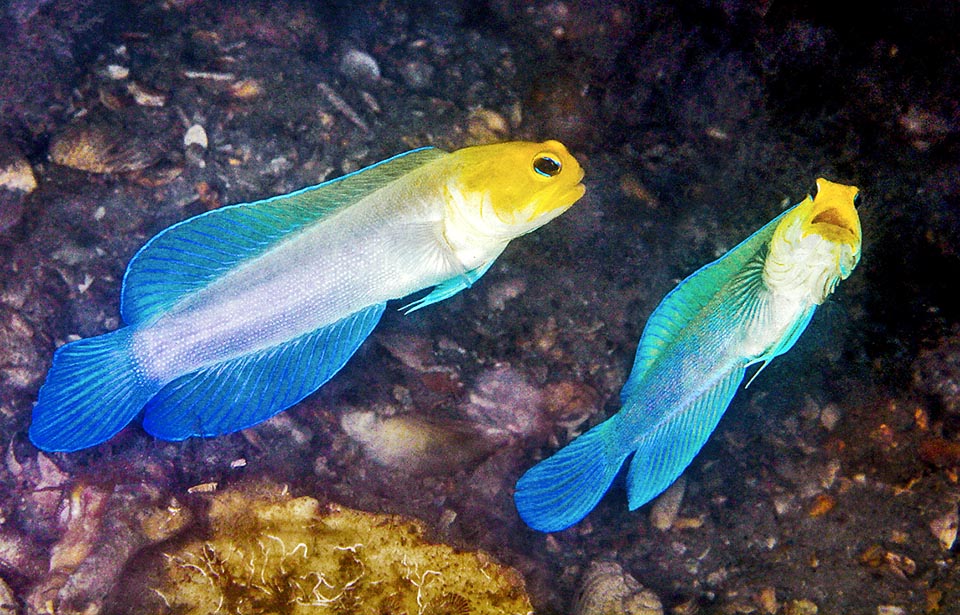
A couple. Opistognathus aurifrons usually lives in small colonies and the partner is often the one of the next door.© Kevin Bryant
Morphophysiology
Opistognathus aurifrons can reach the length of 10 cm.It has a very elegant livery with the yellow shades of the head il refined contrast with the blue of the fins. The eyes, also with pale blue features, are protruding.
The body is scaleless whilst the scales of the body, pearl grey in colour, are cycloid. The lateral line, present only in the fore half of the body, is placed very high, just under the long dorsal fin. This is unique with 11 spiny rays and 15-16 soft. The anal has 3 spines followed by 14-15 unarmed rays and the pectoral ones count 18-20 soft rays.
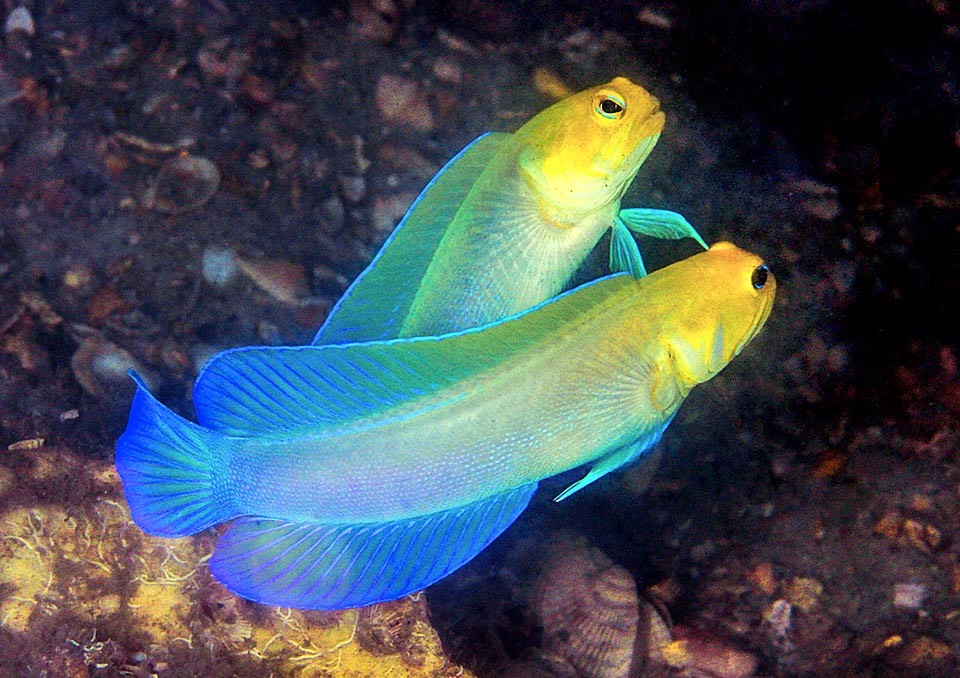
To court her the male often swims with wide open mouth in curved position with the fins stretched towards the partner © Kevin Bryant
Decidedly moved forward, close to the head, the pelvic fins display 1 spiny ray and 5 unarmed. They are long and thin, often stretched forward like two arms. They help in stabilizing the fish and during the courtship they send precise loving messages to the partner.
Before the reproductive period the males may at times display black spots on the nape and depending on the site, some specimens show two dark features on the throat and blue lines on the head.
It is difficult to say if this enters into the variability of the species. In fact, for Brazil, there are those who speak of a new species or subspecies to be described.
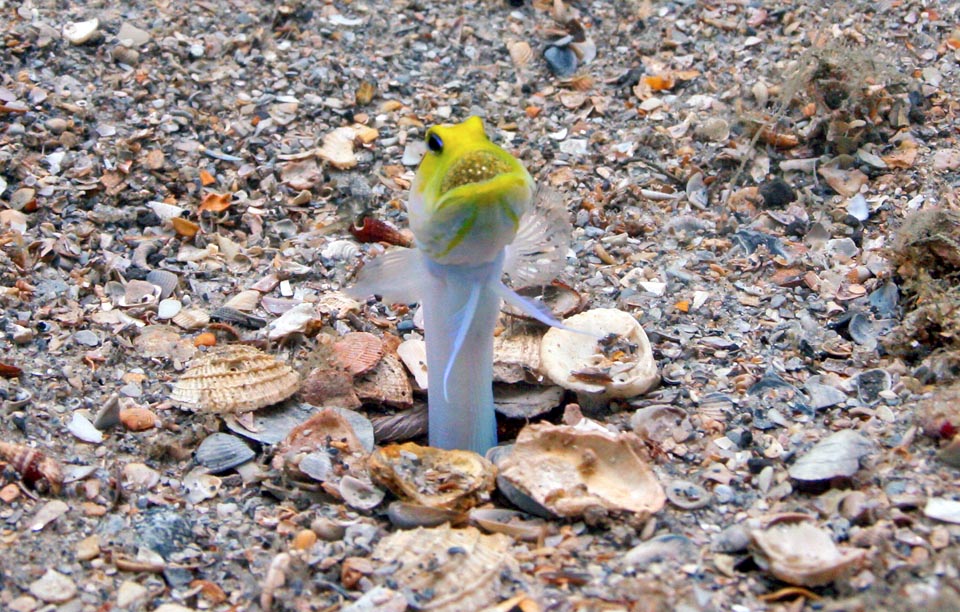
Then our nice puppet stands on the house door for about one week with the fecundated eggs in its mouth © Kevin Bryant
Ethology-Reproductive Biology
Opistognathus aurifrons feed on small benthic and planktonic invertebrates, including the microscopic jellyfishes passing close to its home.
When a fish with bad intentions approaches, it immediately retreats, otherwise, if the size of the intruders allows it, like in the case of the small gobies who want to steal him the den, defends with extreme energy its home violently spitting sand and rocks in its face.
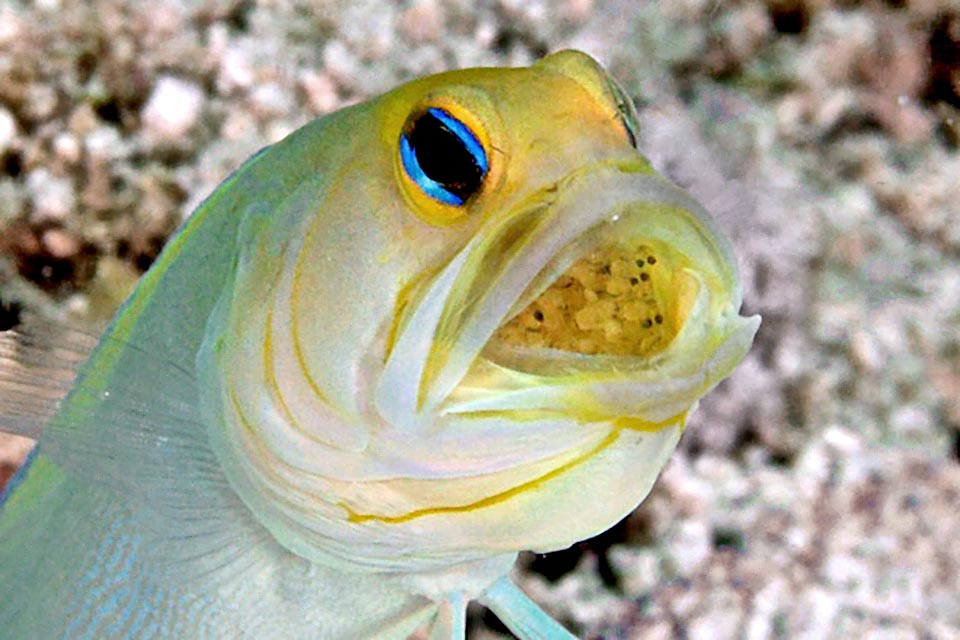
Initially eggs are yellow, then dark orange. They form, stuck, a ball that male spits, catches on the fly and shakes regularly for a good oxygenation © Allison & Carlos Estape
Opistognathus aurifrons is sometimes preyed upon by Epinephelus striatus, a Caribbean grouper that waving the caudal fin like a fan covers its den with sand to force it out.
But the Yellowhead jawfish doesn’t get troubled and can wait quietly even 10 hours in its house waiting for this stubborn grouper to be distracted from another prey.
For reproduction the male courts the female with the mouth wide open swimming in an arched position with the fins stretched towards the partner.
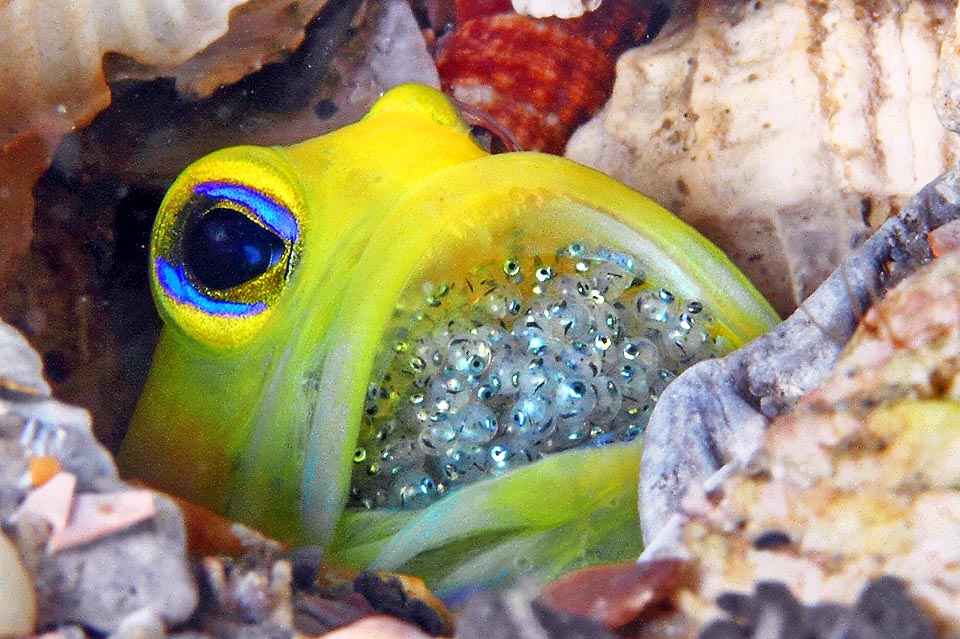
During the last phase, when can be well seen the unborn eyes and mouth, are many transparent spheres shining silvery announcing the happy event © Kevin Bryant
The fecundated eggs are at once collected by the male and the oral incubation lasts about one week.
Stuck together, they form a ball the male spits, picks up on the fly, and regularly shakes for a good oxygenation.
Initially, they are yellow, then dark orange, almost black, and during the last phase, when the eyes of the unborn may be easily seen, they shine transparent and silvery announcing the happy event.
Opistognathus aurifrons can reproduce also in aquariums, fed on larvae of Artemia salina and frozen shrimps of the genus Mysis.
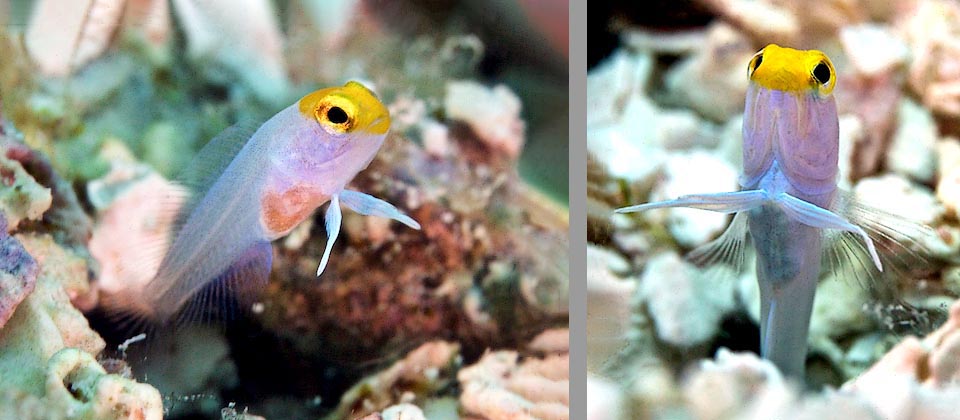
Juveniles take 2-3 weeks before reaching the autonomy and dig their first den. The Yellowhead jawfish has reproduced in aquarium and is not an endangered species © Allison & Carlos Estape
The resilience of the species is unknown, but the fishing vulnerability is very low, marking only 10 on a scale of 100.
Thus, it appears as “Least Concern“, that is with “Minimal Concern” in the IUCN Red List of the endangered species.
Synonyms
Gnathypops aurifrons Jordan & Thompson, 1905.
